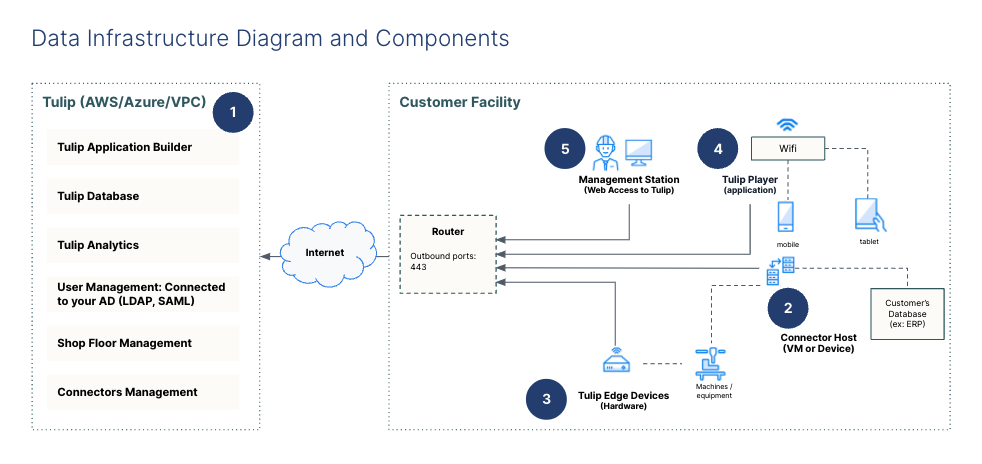Purpose
Here's an overview of how Tulip is organized with 5 major parts.
Depending on which version of Tulip you are using, there can be up to five components of the Tulip platform you’ll interacting with.

(1) Tulip
This is the cloud-based platform where all of the Tulip application creation, editing, management and analytics takes place. This Factory includes the PostgreSQL that store all the data generated by app completions, as well as the MongoDB database that serves up the content in the Tulip applications.
(2) Tulip Connector Host
Connector hosts enable Tulip to communicate locally with databases and networked equipment. Read our What are Connectors article for more information on what Connectors do, and An Introduction to Tulip Connector Hosts for information on how to install Connector Hosts,
(3) Tulip Edge Devices
This is how Tulip connects to local devices to support Tulip Edge Devices. Check out What Can I Do with Tulip IoT? to learn more about Tulip's Edge capabilities.
(4) Tulip Player
This is where Operators will interact with the built Tulip applications on your shop floor.
If you are not familiar with Tulip or Tulip Player, read our Intro to the Tulip Player .
(5) Management Station
To interact with any of the administrative functions of Tulip you’ll need to be able to access your Tulip account at https://your_account.tulip.co, or https://your_account.tulip-mfg.com. The management station is whatever local computer you use to access Tulip.
As you can see in the diagram at the top, none of the components talk to each other within your network. All of these devices utilize outbound connections to Tulip for the initial handshake. These connections use SSL/HTTPS, to ensure all data is encrypted during transit.
Data Flow
The Tulip Player, Edge Devices, Connector Host and Management Stations communicate to Tulip through JSON transferred via WebSockets. The Tulip Player and Tulip Management Stations also download HTML, Javascript, and CSS to render as web pages.
Due to Tulip’s self-serve nature, we cannot state what data will be transmitted and stored on the Tulip platform - this is for our customers to decide!
Data Storage
When using the Tulip Cloud, all data is stored in either a MongoDB or PostgreSQL database on AWS. You do not need to worry about managing storage, or how much data you’re collecting with the Tulip platform. Images, Videos, and PDFs are uploaded to Amazon’s S3 storage.
Firewall Configuration
Read out Networking Requirements for Cloud Deployment for more information on detailed network settings. If you’re planning on using Tulip to connect to a local database at your company, then you’ll want to work with IT on configuring the correct network access for the Connector Host to a) communicate with your database and b) ensure that it will be able to connect to Tulip.

